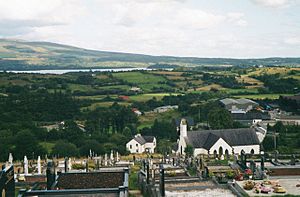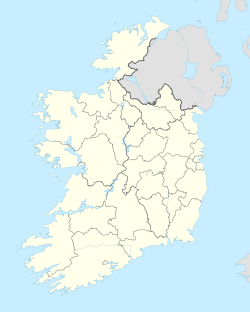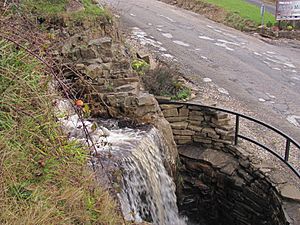Arigna facts for kids
Quick facts for kids
Arigna
An Airgnigh
|
|
|---|---|
|
Village
|
|

Arigna looking towards Lough Allen
|
|
| Country | Ireland |
| Province | Connacht |
| County | County Roscommon |
| Elevation | 86 m (282 ft) |
| Time zone | UTC+0 (WET) |
| • Summer (DST) | UTC+1 (IST (WEST)) |
| Irish Grid Reference | G931142 |
Arigna is a small village located in the northern part of County Roscommon in the west of Ireland. It is close to Lough Allen, a large lake that is part of the River Shannon. Arigna is found along a beautiful scenic route between the villages of Keadue and Sliabh an Iarainn. The village is part of Kilronan parish, which also includes Keadue and Ballyfarnon. For over 400 years, Arigna was well-known for its coal mining industry, which finally stopped in 1990.
Contents
What's in a Name?
The name Arigna comes from an old Irish word, An Airgnigh. This means "the plundering". It was used to describe the Arigna river, which was called the "plundering river".
The older Irish name for Arigna was Carn an Ailt. This name means "pile of rocks" (Carn) and "steep-sided glen, height, or cliff" (Ailt).
Arigna's Coal Mining History
Arigna was famous for its coal mines, where the coal was found in very thin layers. Miners often had to lie on their sides to dig out the coal. Mining continued until 1990. The coal was first used for making iron and later to power a special electricity plant. When the tall chimney of the ESB power station was taken down, it marked the end of coal mining in the area.
Early Mining and Ironworks
Mining in Arigna began a very long time ago, in the Middle Ages (around the 12th to 15th centuries). At first, people mined iron here and at Sliabh an Iarainn. In the early 1600s, new ironworks were built in Arigna. They used charcoal to melt the iron. Charcoal was made by burning wood from the local forests.
However, new trees were not planted, and the forests eventually ran out. Because of this, the ironworks had to close by the end of the 1600s.
Coal Mining Begins
About 65 years later, in 1765, people started mining the coal deposits in Arigna. Then, 30 years after that, the ironworks opened again. This time, they used local coal instead of charcoal to melt the iron. These ironworks were not very successful and finally closed in 1838.
Coal for Dublin and New Towns
In the 1790s, there was a big need for fuel in Dublin, the capital city. The price of coal in Dublin became very high, causing problems for many people. When the Royal Canal was finished, it made it possible to transport Arigna coal to Dublin. This coal was much cheaper, which helped many people.
The demand for coal helped the area grow. New towns and villages, like Drumshanbo, started because of these industries.
The Power Station and Mine Closure
Coal mining continued to provide jobs for people in Arigna. The coal was used to heat homes and hospitals. It also powered steam engines. In 1958, the Arigna 15-megawatt (MW) Power Station opened. This was a big step for the region of Connacht, as it was the first major power station there.
The station was built specifically to burn the local coal, which had a lot of ash. At its busiest, the power station burned 55,000 tonnes of coal each year and employed 60 people. The main reason for this power station was to keep jobs in the local mining industry.
However, by the mid-1900s, coal from other countries became much cheaper. This was because it came from bigger mines that were easier to dig. In the 1980s, the ESB decided to close the power plant. Without its main customer, the Arigna mine closed in 1990. The power station officially stopped working in 1993.
How Miners Worked
Because the coal layers were thin, a special way of mining was used in Arigna. A main tunnel was dug, and from it, smaller tunnels branched out every 5 to 6 meters. The coal was dug from these smaller tunnels. These tunnels were quite low, and miners often had to lie on their backs to cut the coal.
These miners, called 'Cutters' or 'Brushers', also prepared the mine for the next day. They used explosives to make the tunnels longer. 'Drawers' filled small carts called 'hutches' and pushed them to the main underground road. Here, the hutches were connected to a rope system that pulled them outside. Sometimes, small diesel trains were used to pull the hutches out of the mine. 'Proppers' used wooden pillars to hold up the mine roof and keep it safe.
Life Inside the Mines
The author Brian Leyden wrote about what life was like in the mines in his book, The Home Place. He described the tough conditions miners faced. He said the coal mines were very small compared to mines in other countries. Miners often had to lie in water on their backs. They used a handpick or a short shovel to get coal from under a rock ledge.
Leyden also wrote that a religious picture was placed at the mine entrance. Coal miners would bless themselves there before going underground. Visitors who came to see the mines often found the experience so scary that they could not go past this picture.
Preserving Mining History
Today, you can visit the Arigna Mining Experience. It has an exhibition and an optional underground tour. Former miners lead the underground tour. They can answer any questions about how coal was mined. The tour can be a bit challenging because the mine tunnels are low in some places.
You don't have to go deep down into the ground. The entrance and the whole tour are on a flat level. It is even accessible for wheelchairs. Visitors get hard hats to protect their heads. Lights and sounds inside the mine help make the experience feel real.
In April 2009, a musical show called Scars On the Mountain was launched by RTÉ, Ireland's main broadcaster. It celebrated Arigna's mining history.
Getting Around Arigna
Arigna railway station opened on May 2, 1888. It was part of the Cavan and Leitrim Railway, which used a narrow gauge track. This means the tracks were closer together than usual. The station finally closed on April 1, 1959.
Famous People from Arigna
- Brian Leyden - A well-known writer and author.
- Packie Duignan - A talented flautist (someone who plays the flute).
- Peter and Mark Keaveney - Founders of Peter Mark, a famous hairdressing company.
- Peter Lynch - An Irish politician who served as a senator.
See also
 In Spanish: Arigna para niños
In Spanish: Arigna para niños



